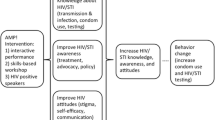Abstract
The purpose of this study was to determine the training effects on school personnel’s knowledge, attitudes, comfort, and confidence levels toward educating students about HIV/AIDS in Pennsylvania. The following four research questions were explored: (a) What is the knowledge, attitudes, confidence, and comfort levels of school personnel regarding the teaching of HIV/AIDS to school aged children?; (b) How do HIV/AIDS trainings affect the knowledge, attitude, confidence, and comfort levels of school personnel?; (c) What extent do the demographics of the school personnel influence their knowledge, attitude, confidence, and comfort levels in teaching HIV/AIDS?; (d) Can knowledge of HIV/AIDS predict confidence, attitudes, and comfort levels? The subjects (N = 341) included in this study were part of the “HIV Update: A Workshop for Educators” sponsored by the Pennsylvania Department of Education. These trainings were made available to school personnel across the state of Pennsylvania during a 3 year period. Data was gathered from pre- and post-tests and included measures that targeted subjects’ knowledge, attitudes, comfort levels, and confidence levels associated with HIV/AIDS. Survey questions were analyzed using descriptive statistics, paired t-test, one-way analysis of variance (ANOVA), Tukey post hoc analysis, and the bivariate regression analysis. The results of this study indicate that participation in 6-hour HIV update trainings had a statistically significant positive effect on increasing school personnel’s comfort, confidence, and knowledge levels. It was further determined the trainings improved participants’ attitudes toward individuals with HIV/AIDS. Increasing participants’ knowledge of HIV/AIDS was also shown to predict confidence, attitudes, and comfort levels of school personnel. This study indicates that HIV/AIDS update trainings should be a priority for school personnel in order to increase their knowledge, comfort, confidence, and attitudes in addressing the needs of students and their families in an appropriate educational setting.
Similar content being viewed by others
References
Ballard, D., White, D., & Glascoff, M. (1990). AIDS/HIV education for preservice elementary teachers. Journal of School Health, 60, 262–265.
Bridges, W. (2003). Managing transitions: Making the most of change (2nd ed.). New York: Perseus.
Brucker, B., & Hall, W. (1996). Teachers’ attitudes toward HIV/AIDS: An Americannational assessment. Early Childhood Development Care, 115, 85–98.
CDC. (2006). Twenty-five years of HIV/AIDS-United States, 1981–2006. Morbidity and Mortality Weekly Report.
Dawson, L. J., Chunis, M. L., Smith, D. M., & Carboni, A. A. (2001). The role of academic discipline and gender in higher school teachers’ AIDS-related knowledge and attitudes. Journal of School Health, 71, 3–8.
Evans, R. (1996). The human side of school change. Wiley.
Gingiss, P., & Basen-Engquist, K. (1994). HIV/AIDS education practices and training needs of middle school and high school teachers. Journal of School Health, 64(7), 290–295.
Heifetz, R. A., & Linsky, M. (2002). The heart of danger. In Leadership on the line: Staying alive through the dangers of leading, (Chapter 1). Boston, MA: Harvard Business School.
Kaser, J., Mundry, S., Stiles, K., & Loucks-Horsley, S. (2006). Leading every day: 124 actions for effective leadership. Thousand Oaks, CA: Sage.
Kirby, D., Short, L., Collins, J., Rugg, D., Kolbe, L., Howard, M., et al. (1994). School-based programs to reduce sexual risk behaviors: a review of effectiveness. Public Health Reports, 109, 339–360.
Remafedi, G. (1993). The impact of training on school professionals’ knowledge, beliefs, and behaviors regarding HIV/AIDS and adolescent homosexuality. Journal of School Health, 63, 153–157.
Richter, J. (1997). HIV/AIDS related knowledge levels and instructional confidence levels of Texas secondary school teachers. Texas Alliance for Health, Physical Education and Dance Journal, 65, 9–12.
Stine, G. J. (2003). AIDS update 2003: An annual overview of acquired immune deficiency syndrome. Prentice Hall.
Stinnet, T., Cruce, M., & Choate, K. (2004). Influences on teacher education towards youth who are HIV positive. Psychology in the Schools, 41, 2.
United Nations Program on HIV/AIDS (UNAIDS). (2004). AIDS epidemic update. Geneva, Switzerland: UNAIDS.
United Nations Program on HIV/AIDS (UNAIDS). (2005). AIDS epidemic update. Geneva, Switzerland: UNAIDS.
Author information
Authors and Affiliations
Corresponding author
Rights and permissions
About this article
Cite this article
Deutschlander, S. An Analysis of Training Effects on School Personnel’s Knowledge, Attitudes, Comfort, and Confidence Levels Toward Educating Students About HIV/AIDS in Pennsylvania. Int J Ment Health Addiction 8, 444–452 (2010). https://doi.org/10.1007/s11469-009-9221-5
Received:
Accepted:
Published:
Issue Date:
DOI: https://doi.org/10.1007/s11469-009-9221-5




